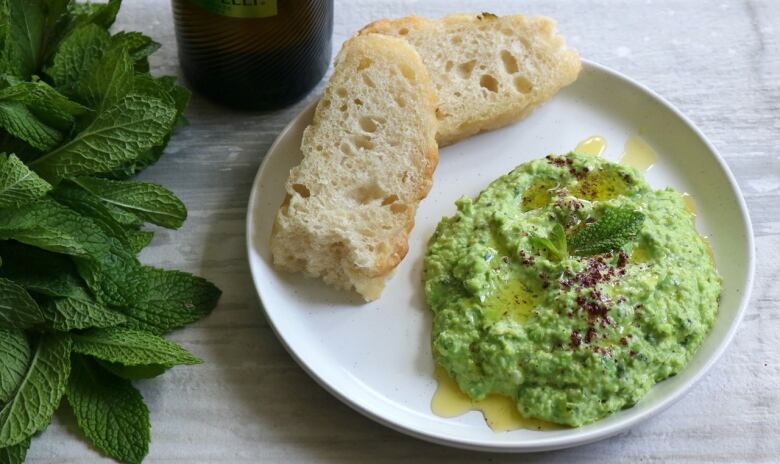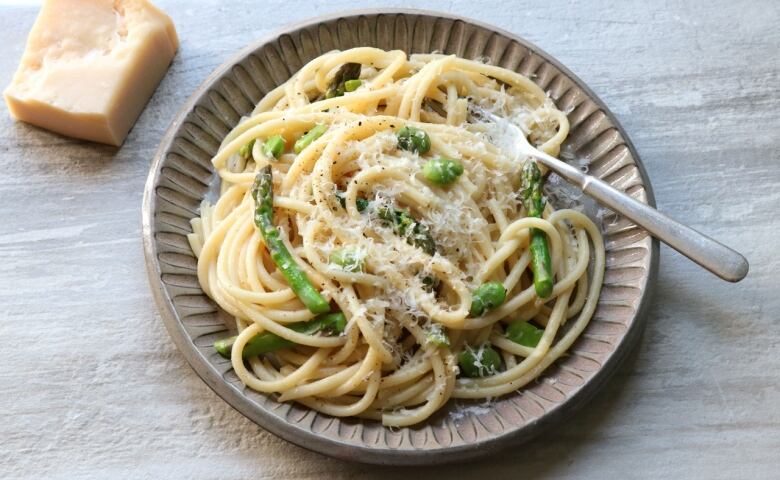Recipes with Julie Van Rosendaal: Fabulous fava
These versatile beans can be served up as dips, added to pastas and grilled as snacks

As spring arrives and everyone is anxious for fresh, new green things in the markets, fava beans are among the first arrivals, along with asparagus and fiddleheads.
Fava,also known as faba or broad beans,are believed to be one of the earliest cultivated crops, a staple of the Middle Eastern diet since around 6000 BC.
You can buy favas dried, canned and frozen any time of year, but for a month or so as spring turns to summer, you can buy them in their fresh state.
Fresh favas are big, spongy beans that need a little extra work to access. You'll need to extract the beans from their protective pods, which are lined with material that feels like soft Styrofoam, and then peel the beans themselves each wears its own little protective jacket.

You can peel them raw. Use a paring knifeto make a slit along one side and pop them out.However, I find it easier to boil or steam them for three to five minutes first, until they soften and lose some of their green colour, then squeeze the tender beans out of their rubbery skins.
In southern Italy, it's customary to pile fava beans up on the table in the spring to shell and eat raw, paired with pecorino, salami, baguettes and wine.
- Bookmarkcbc.ca/juliesrecipesto keep up with all of Julie Van Rosendaal's dishes
I like them a bit better cooked and cooled they're easier to squeeze out of their skins or you could drizzle whole pods in oil, sprinkle them with salt and toss them on the grill whole until they char on the outside and the pulses steam inside. Then let everyone peel and eat them at the table.
Favas are also often mashed or pureed with garlic, lemon and herbs and spread on crostini, or turned into hummus,and you can simmer them and keep them in the fridge to pop into pastas and salads.
Fava and Dill Dip

Favas make wonderful dips or spreads.I referred to one of my most used cookbooks, Zaitoun: Recipes from the Palestinian Kitchen, by Yasmin Khan, for some direction. She says this improves over time in the fridge, so it's perfect to make ahead and dip into all week long, or make ahead to pack for a picnic.
Ingredients:
- lb. fresh or frozen fava beans (out of their pods)
- -1 cup green peas
- juice of 1 lemon, or to taste
- 1 garlic clove, crushed
- cup thick plain yogurt (or to taste)
- 2 tbsptahini (optional)
- a small handful of mint leaves (plus extra for garnish)
- 2 tbspchopped fresh dill
- tspsumac, plus extra to serve
- salt and pepper, to taste
- extra virgin olive oil
Directions:
Bring a saucepan of water to a boil and cook the fava beans for 3-5 minutes, then scoop out with a slotted spoon into a bowl of cold water to stop them from cooking. Put the peas into the water on the stovetop to cook for a few minutes while you squeeze the favas out of their skins into the bowl of a food processor.
Drain the peas, rinsing them under cool water, too, and add them to the food processor with the lemon juice, garlic, yogurt, tahini, mint, dill, sumac and a big pinch of salt and a good grind of black pepper. Add about two tablespoons of olive oil and blitz until relatively smooth. Taste and adjust the seasoning, adding more lemon if you like, or more olive oil to loosen it up. Serve drizzled with extra olive oil and a few mint leaves.
Serves: About 4.
Cacio e Pepe

Cacio e Pepe is a simple, traditional Roman pasta dish with pepper and cheese, and it makes a perfect vehicle for spring veggies like fava beans and asparagus.
Ingredients:
- 1-2 cups fava beans, out of their pods
- 8 oz. (250 g) long, dry pasta, such as spaghetti, bucatini or linguine
- 2-3 few asparagus stalks, cut into 1-2-inch lengths (optional)
- 2 tbspextra virgin olive oil
- 2 tbspbutter
- 1-2 tspfreshly ground black pepper
- 1-1 cups finely grated pecorino Romano or Parmesan cheese (even better, a combo), plus extra for serving
Directions:
Bring a pot of salted water to a boil and cook the podded fava beans for 3-5 minutes, until softened and losing some of their colour. Scoop them out with a slotted spoon into a bowl of cool water to stop them from cooking, then slip them out of their skins.
Cook the pasta in the water (the same, or fresh salted water) until al dente. If you like, add some asparagus for the last minute or two of cooking time. Before draining, scoop out about a cup of the starchy cooking water with a ladle or measuring cup.
As the pasta cooks, heat the oil in a large skillet (one that will accommodate your pasta) over medium heat, grind in a generous amount of pepper and allow it to toast for about a minute. Add the butter and about cup of the starchy water and whisk it all together.
Drain and add the pasta (or transfer it to the skillet with tongs). Add the fava beans and cheese and toss with tongs, adding more hot pasta water until it emulsifies and turns into a creamy sauce. Serve immediately.
Serves: 4.
- Check out Julie Van Rosendaal's full interview on theCalgary Eyeopenerbelow:












_(720p).jpg)


 OFFICIAL HD MUSIC VIDEO.jpg)
.jpg)



























































































